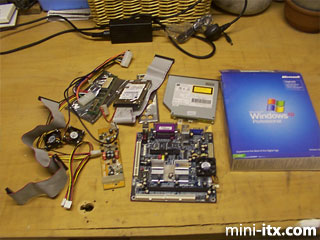Posted on December 1, 2003
Introduction
I needed a small Windows XP machine and a Mini-ITX board was the obvious choice. So I decided to build my "Windows XP Box" in a Windows XP box. The external dimensions of the box are a tiny 243mm x 200mm x 48mm.
|
My requirements were:
- Use as powerful a motherboard as possible for the size i.e. a Nehemiah EPIA M10000.
- It must have an internal CD drive (this size eating requirement turned out be be very hard to meet).
- No bits could be cut off the motherboard to make it fit.
- The box must not bulge in an unsightly way, nor can the box be made bigger.
- It must not burst into flames when working hard (this should always be a requirement of a computer project).
Fortunately there is no longer any requirement for an internal floppy drive. That would have have defeated me.
Construction
The bits arrive and it looks like an impossible task, with too many bits to fit in a small space.
|
I nearly gave up and decided it was an impossible task. The Windows XP box was 3mm thinner and 12 mm narrower than the Adobe Acrobat box I had measured up when first deciding if the project was going to be possible. The challenge was to arrange the components into a 3D jigsaw, then decide how to build enough of an internal support case to get everything to stay in place.
Eventually it looked like I might have a possible layout, but the tolerances were tight. I had 6mm to spare on the long internal dimension of the box and only 3mm to spare on the thickness of the box, and this was not allowing for any thickness for the internal support case that holds everything in place.
|
In order to mount all the bits I was going to have to make an inner support case that would tightly slide into the cardboard box. I chose Wonderboard plastic as my construction material because it is reasonably strong and very easy to work with (it cuts with a Stanley knife). It would have been nice to use aluminium, but the cramped design made the chances of a short circuit too great.
The first construction step was to cut out a base plate the exact size of the inside of the cardboard box and double check where the bits will fit.
As the Wonderboard was 3mm thick this reduced my tolerance in two dimensions to zero. The CD drive would touch one side of the inner support case. The deep part of the CD drive would touch the heat sink on the motherboard, with the narrow bit being able to overlap it, and the far side of the motherboard touches the other side of the Wonderboard case. In the other dimension it was even harder. The top of the sound connector would touch the support case, and the underside of the motherboard would touch the cardboard box. Fortunately the hard drive can slide under the motherboard as this is above (below?) the unused PCI slot. The only place left for the PSU was above the hard drive with the bulky connectors facing down towards the CD both to the front and the back of the hard drive.
|
Now I could position the CD drive hard against the side and start assembling the support case. In the next picture you can see the step up between the thin part of the CD drive and the thicker part of the main body of the drive. The heat sink on the Mini-ITX board touches this step.
|
After much cutting and half a tube of glue the case was finished. I built pillars to support three corners of the motherboard and the power supply and added brackets to support the CD and the hard drive. In such a compact design cooling was a concern so I made fan mounting points in opposite corners of the case. To keep the CPU nice and cool I cut a hole for it it the side of the case and glued in a couple of plates to act as ducting so the CPU fan will only suck in cold outside air. The other two fans are the exhaust points. The fan guards were cut out of a metal speaker grill using an angle grinder as neatly drilling that many holes is just not fun. Angle grinders are almost as much fun to use as chain saws.
|
 |
 |
 |
Quick Links
Mailing Lists:
Mini-ITX Store
Projects:
Show Random
Accordion-ITX
Aircraft Carrier
Ambulator 1
AMD Case
Ammo Box
Ammo Tux
AmmoLAN
amPC
Animal SNES
Atari 800 ITX
Attache Server
Aunt Hagar's Mini-ITX
Bantam PC
BBC ITX B
Bender PC
Biscuit Tin PC
Blue Plate
BlueBox
BMW PC
Borg Appliance
Briefcase PC
Bubbacomp
C1541 Disk Drive
C64 @ 933MHz
CardboardCube
CAUV 2008
CBM ITX-64
Coelacanth-PC
Cool Cube
Deco Box
Devilcat
DOS Head Unit
Dreamcast PC
E.T.PC
Eden VAX
EdenStation IPX
Encyclomedia
Falcon-ITX
Florian
Frame
FS-RouterSwitch
G4 Cube PC
GasCan PC
Gingerbread
Gramaphone-ITX-HD
GTA-PC
Guitar PC
Guitar Workstation
Gumball PC
Hirschmann
HTPC
HTPC2
Humidor 64
Humidor CL
Humidor II
Humidor M
Humidor PC
Humidor V
I.C.E. Unit
i64XBOX
i-EPIA
iGrill
ITX Helmet
ITX TV
ITX-Laptop
Jeannie
Jukebox ITX
KiSA 444
K'nex ITX
Leela PC
Lego 0933 PC
Legobox
Log Cabin PC
Lunchbox PC
Mac-ITX
Manga Doll
Mantle Radio
Mediabox
Mega-ITX
Micro TV
Mini Falcon
Mini Mesh Box
Mini-Cluster
Mobile-BlackBox
Moo Cow Moo
Mr OMNI
NAS4Free
NESPC
OpenELEC
Osh Kosh
Pet ITX
Pictureframe PC
Playstation 2 PC
Playstation PC
Project NFF
PSU PC
Quiet Cubid
R2D2PC
Racing The Light
RadioSphere
Restomod TV
Robotica 2003
Rundfunker
SaturnPC
S-CUBE
SEGA-ITX
SpaceCase
SpacePanel
Spartan Bluebird
Spider Case
Supra-Server
Teddybear
Telefunken 2003
TERA-ITX
The Clock
ToAsTOr
Tortoise Beetle
Tux Server
Underwood No.5
Waffle Iron PC
Windows XP Box
Wraith SE/30
XBMC-ION






